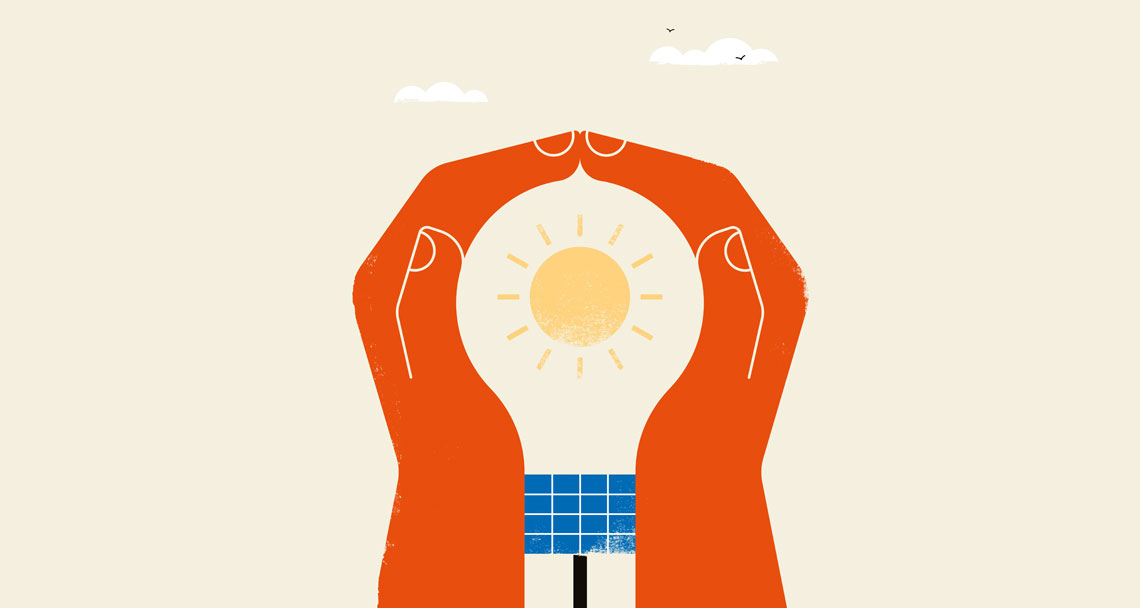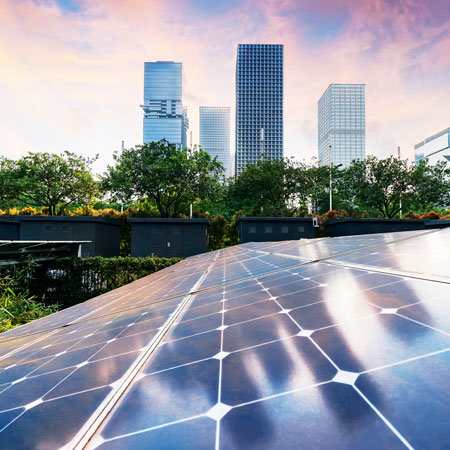Cheaper, more efficient solar panels and the modular nature of energy production makes solar power the perfect fi t for real estate, allowing the sector to evolve and embrace solar’s huge potential.
The sun is the ultimate source of almost all the energy used on earth, and trapping that energy is cheaper and more efficient than ever before. Solar is the fastest-growing form of renewable energy, and real estate can play a significant part in that growth story.
The International Energy Agency (IEA) forecasts renewables will overtake coal as the largest source of electricity generation by 2025, supplying one third of the world’s electricity. It predicts solar will show the strongest growth over the next two decades.
“Every day we get enough energy from the sun to power our planet for 27 years”
Thomas McMillan, Head of Energy Consulting at Savills, says: “Every day we get enough energy from the sun to power our planet for 27 years. Solar alone has the potential to reduce global carbon emissions by up to 25% by 2050 and it’s a technology that works today.”
Solar power is cheaper than ever, thanks to the steadily decreasing cost and improved efficiency of solar panels – between 2015 and 2019, the cost of solar modules fell 41.2% globally. The IEA says solar is the cheapest electricity in history in some markets.
Seasonality of sunshine is an obstacle for solar in temperate climates. However, the sunny climate of the Middle East is driving substantial investment in solar, says Stuart Healey, Commercial Director, Building & Projects Consultancy, Savills Dubai. “The region is leading on various fronts, such as hosting the largest singlesite solar park at Mohammed Bin Rashid Al Maktoum Solar Park in Dubai; investing $50 billion into renewable energy by 2023 in Saudi Arabia; and setting ambitious targets, such as the Egyptian government’s plan to obtain 42% of the country’s electricity from renewables by 2034.”
Solar: the perfect fit
Investors in solar energy production face upfront costs for systems and installation, but minimal ongoing costs, while maintenance is simple and relatively cheap: a broken panel is easy to replace and does not bring the whole system down.
The modular nature of solar makes it “the perfect fit for real estate,” says McMillan. “It can be installed on a roof or a canopy over a car park, allowing asset owners to generate their own electricity.” Solar panels are installed on buildings as diverse as the Burj Khalifa in Dubai, the White House in Washington, DC, and the ‘Sundial building’ in Dezhou, China, a conference and exhibition centre with 5,000 sq m of solar cells on its roof.
Solar alone has the potential to reduce global carbon emissions by up to 25% by 2050
Solar can work for the façade as well as the roof. South Korean conglomerate Hanwha recently remodelled its office tower HQ in Seoul with a façade that includes upwards-angled solar panels. The panels also shade the windows below, reducing heat gain.
The low, wide profile of warehouse buildings means solar panels have proven popular with logistics real estate companies. Asia-Pacific logistics specialist ESR had solar panels installed on close to two million sq m of warehousing across the region, according to its 2019 annual report, and generated 95,000 GJ over the year, enough to power 2,500 homes.
Commercial real estate owners who install solar can benefit from lower electricity costs. The Solar Energy Industries Association estimates an average US office building could save 20-40% on its annual energy bill from installing solar panels.
The use of renewables can contribute to company ESG goals or to meeting the requirements of green legislation. Asset owners can also potentially sell surplus power back to the grid. For example, the UK’s Smart Export Guarantee scheme allows excess renewable power to be sold to energy companies for 2-5.6p per kWh.
The millions of dwellings in the residential sector provide a significant opportunity for solar. For homeowners, the main obstacles are the cost of retrofitting and the appearance of the panels. However, developers are fitting solar panels on many new homes in Europe and roof-integrated panels are less obtrusive.
Tomorrow’s target: Panels on every roof
“The story of solar in the past decade has been that of price reductions achieved through technological development and economies of scale. As cell efficiency has improved as well, the power capacity of a panel has risen by a third in the past five years. Work is underway on new tech which could boost that by a further 50% in the future.
Regulation is a big driver for us; we make roof-integrated solar panels that are used by housebuilders in the UK and Europe to ensure new homes meet ever more stringent emissions targets.
Over the next decade, the big story will be the partner technologies that are enablers for solar power.
Battery storage is the obvious one; most people who add solar to their own homes now include battery storage. Another is smart energy grids, where price signals are used to align consumption to availability. These work alongside smart devices, such as fridges that can regulate how hard they run, depending on the electricity price.
Declining battery costs mean the payback for installing our panels is now around eight years and falling.
In 2050, good for the solar industry will mean panels on every roof.”
Stuart Elmes



